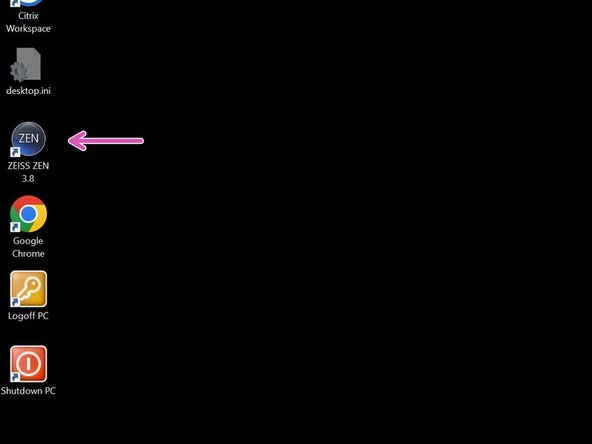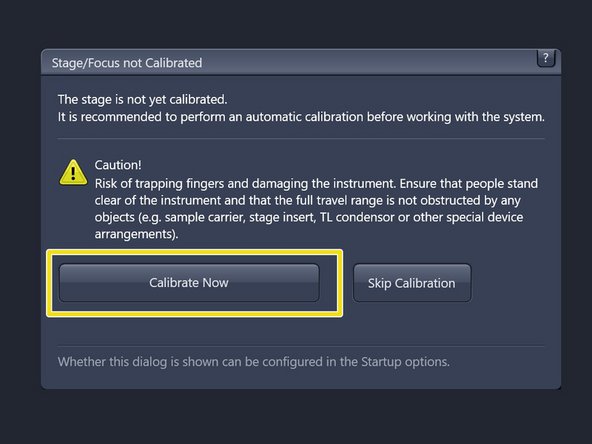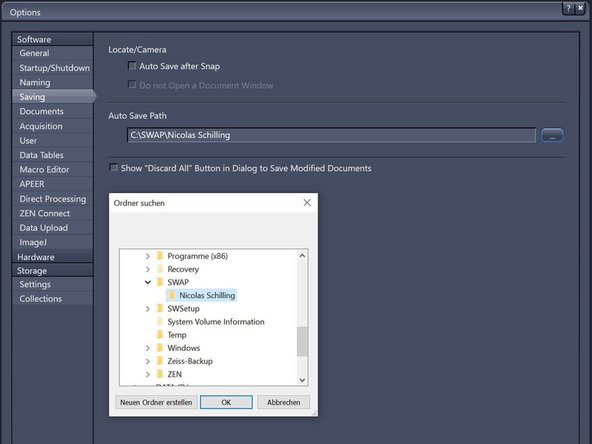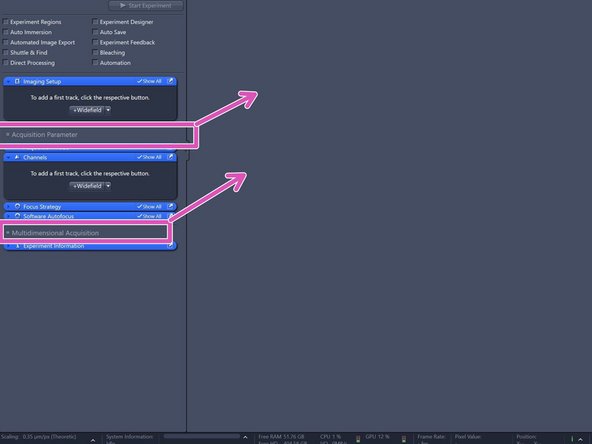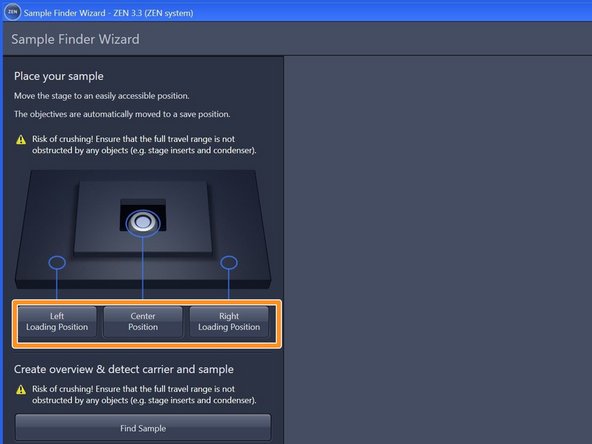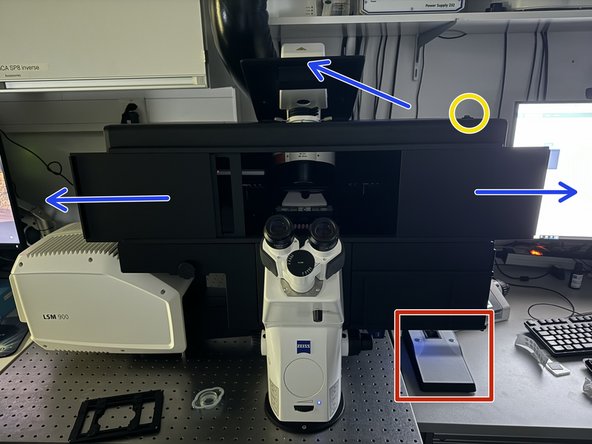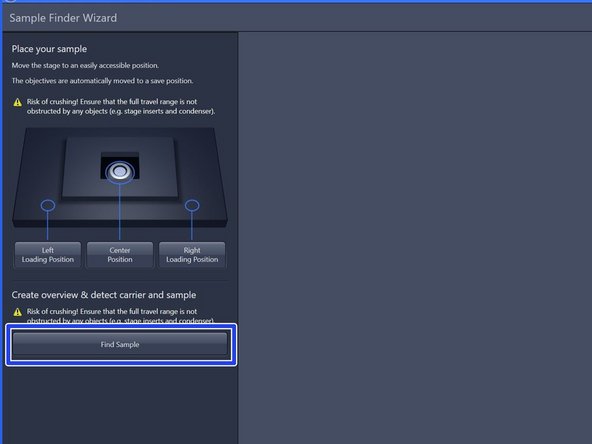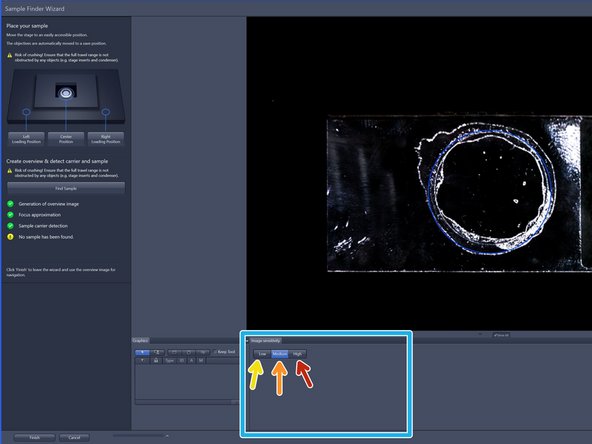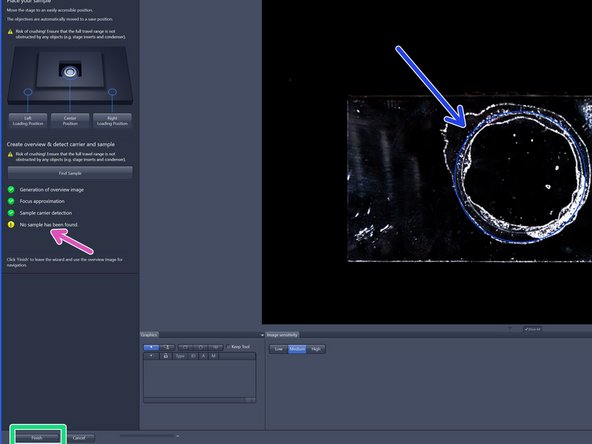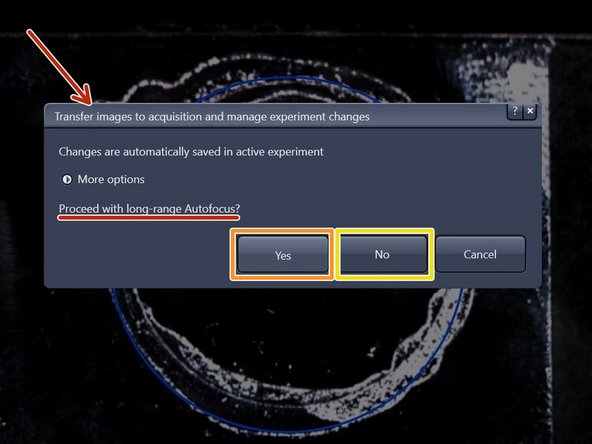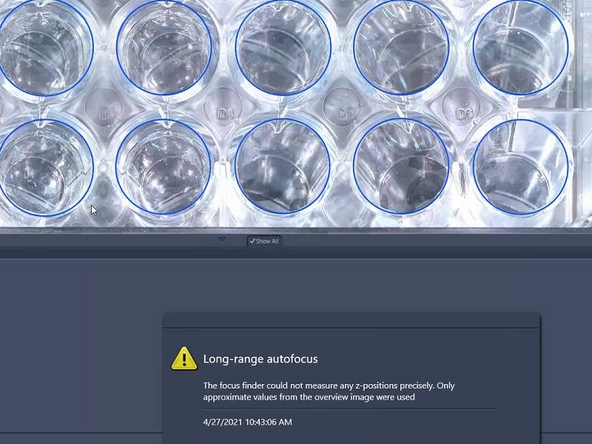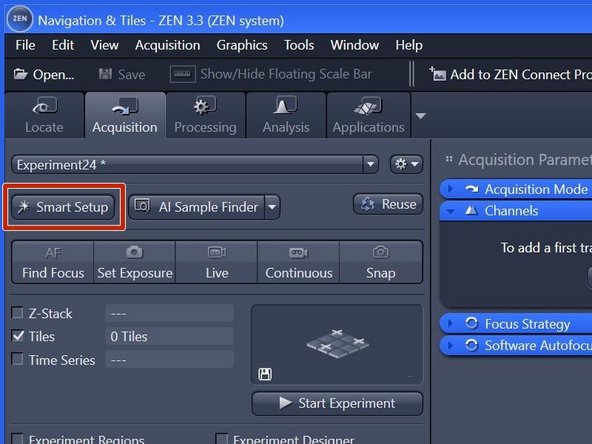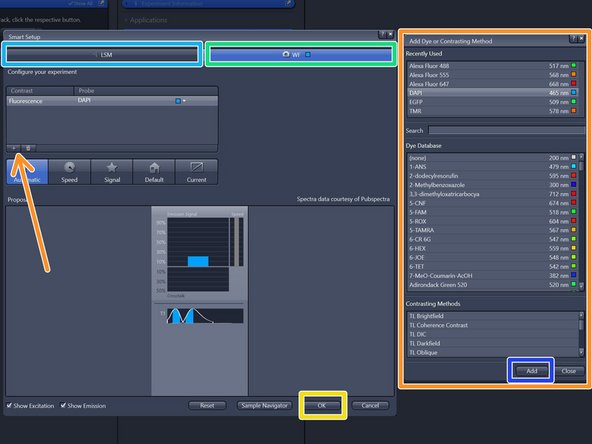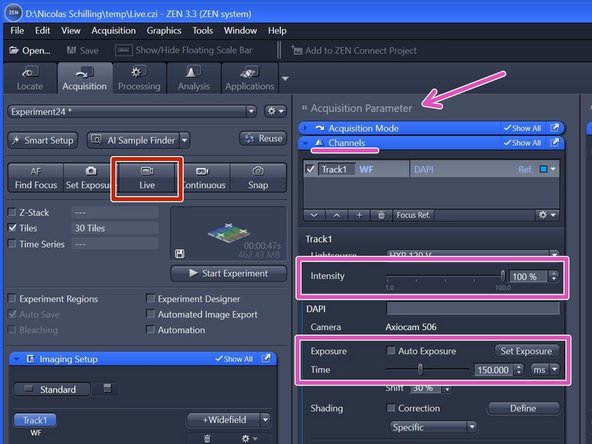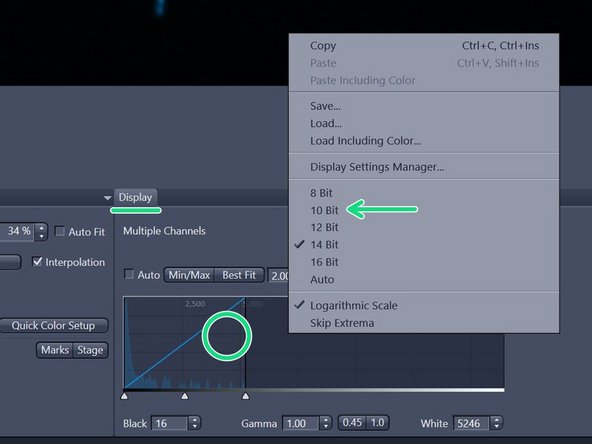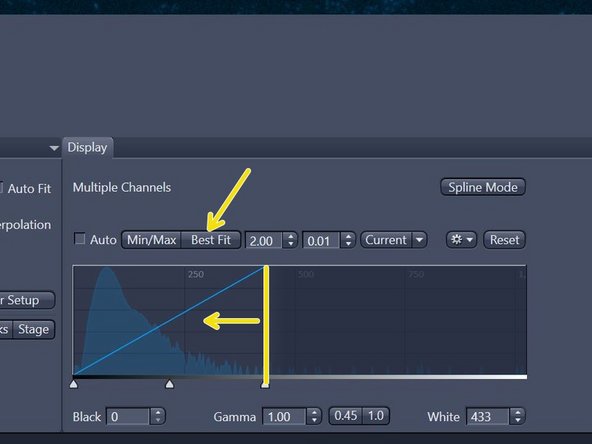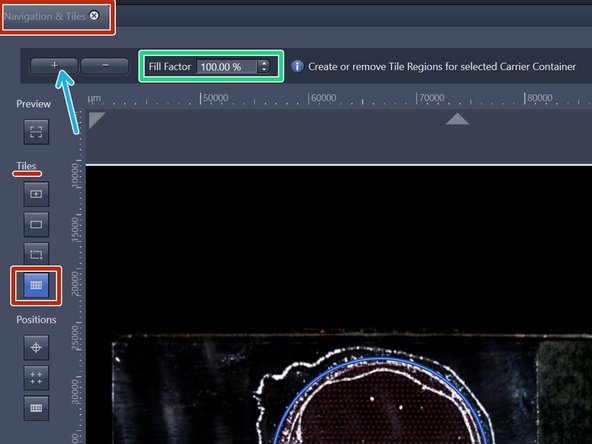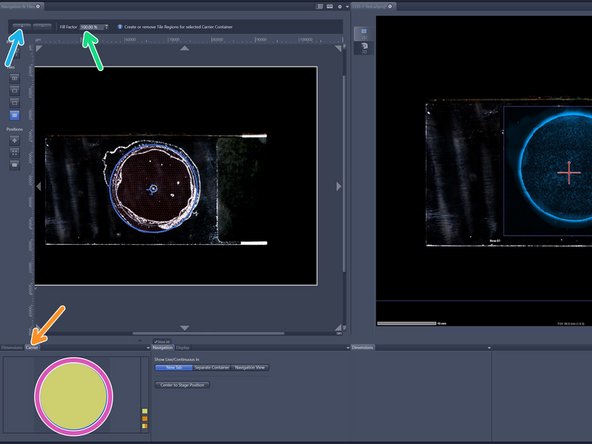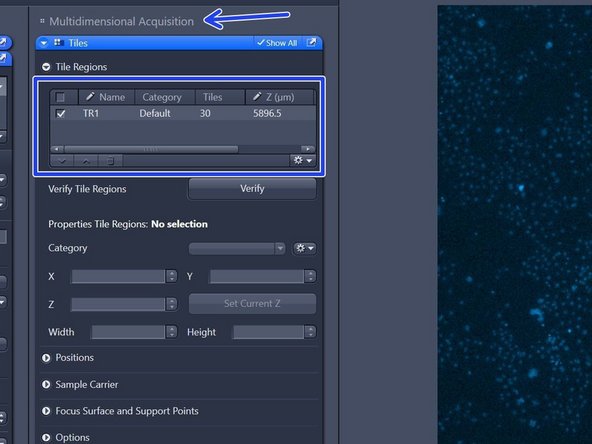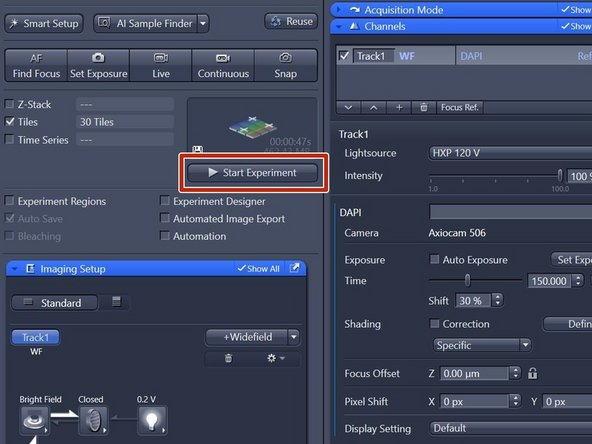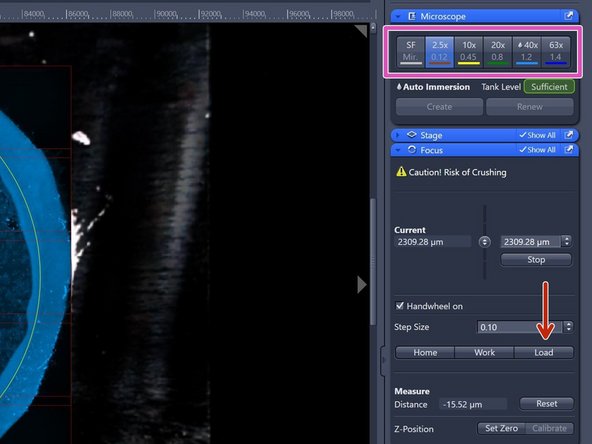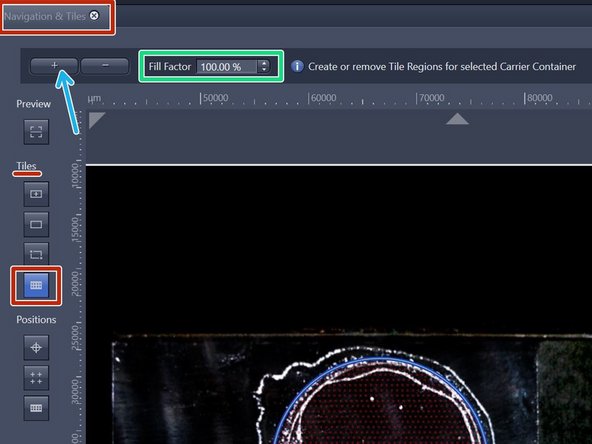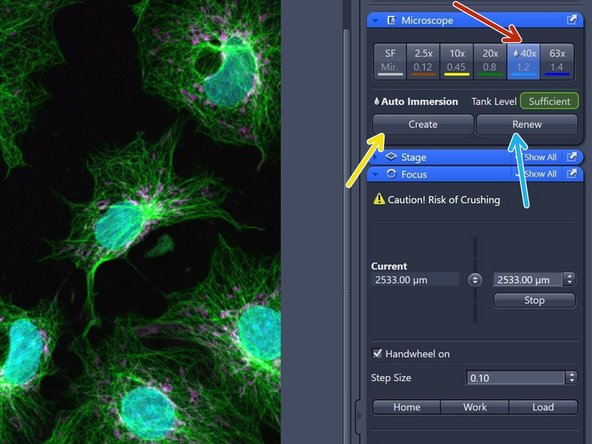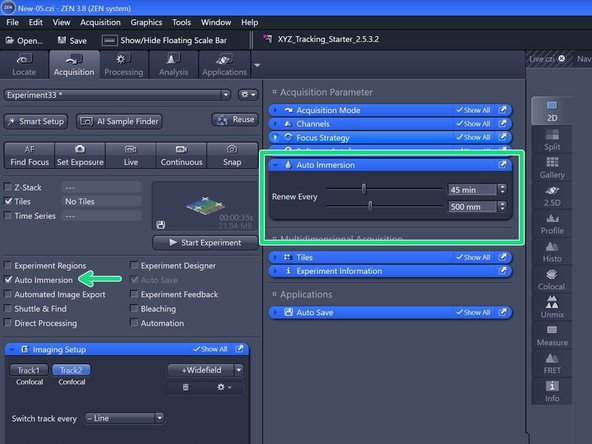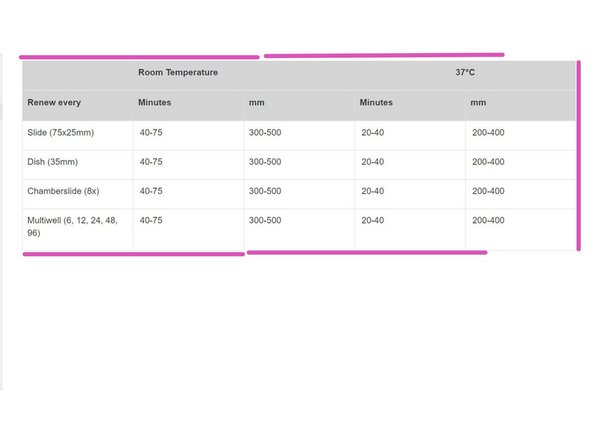Introduction
In this guide of the Center for Microscopy and Image Analysis we show how to start up the microscope and software, mount a sample and find the focus on the Zeiss LSM 900 microscope. With the AI Sample Finder you quickly find your sample, easily acquire an overview image for navigation and define potential regions of interest. While using ZEN Connect along all subsequent images will automatically be displayed in context. Further, one can easily use ZEN Connect to align and overlay images from any other microscope source.
-
-
Switch ON "system" and "components".
-
Make sure laser key is on "I" position.
-
PC is always on to to ensure continuous automatic data transfer by data mover.
-
Turn on the power strip for live cell components (mandatory), otherwise ZEN will display an error message when starting the software.
-
-
-
Sign-in with your ZMB core credentials.
-
In case you forgot your password please follow this link.
-
-
-
Start the "ZEN 3.x (blue edition)" software
-
Choose "ZEN "
-
Make sure there is no sample on the microscope stage and calibrate the stage by clicking "Calibrate Now".
-
The system will automatically initialize the hardware.
-
-
-
In the "ZEN" software go to Tools > Options.
-
Choose "Saving" and check that the "Auto Save Path" is set to the C:\SWAP drive. If not, please change accordingly.
-
Please generate a new folder with with your username. C:\SWAP\ZMB-USERNAME e.g. C:\SWAP\j.doe.
-
This path setting is saved to your profile and should persist even after log-out or restarting the microscope.
-
-
-
Switch to the "Acquisition" tab.
-
By clicking and holding the menu titles you can move around the menu boxes and also extend the menu to two columns for easier menu navigation.
-
These settings are saved in your profile and should be retained even after logging out or restarting the microscope.
-
-
-
This optional step is highly recommended for easier data management. ZEN Connect organizes your data in a map-like structure, allowing you to see exactly where each piece of data was acquired in your overview.
-
Open the "ZEN Connect" tab (right hand side in "ZEN" software).
-
Choose "Create".
-
Define "Project Path".
-
Create a new folder with your core name e.g. n.schilling in "D:\automatic_transfer\files" and use that as a file path for ZEN Connect.
-
For more information check out the corresponding data mover guide. Data Mover ZEISS LSM 900 (Schlieren)
-
Click "OK".
-
"ZEN Connect" correlates all data associated with your sample. It allows you to map high-resolution images on the larger overviews, maintaining the context and simplifying your file organization.
-
-
-
The "AI Sample Finder" allows you to place your sample, capture an overview image, identify & align your sample carrier and adjust the focus for each region. ''
-
The "AI Sample Finder" is currently compatible with slides 76 x 26 mm, 35 or 50 mm dishes, chamber slides (1x, 2x, 4x, 8x, 10x), Multiwell plates round (6x, 12x, 24x, 48x, 96x) Multiwell plates (96x angular).
-
Click "AI Sample Finder" in the "Acquisition" tab.
-
Select an appropriate "Loading Position" within the "Sample Finder Wizard". ➔ The motorized stage moves to the selected position for sample loading.
-
-
-
Push back the condenser arm and open the upper doors.
-
Turn ON the incubation box light.
-
In the wall mounted drawer, multiple stage inserts are available.
-
Place your sample with the coverslip facing down.
-
How to insert your different samples (slides, dishes or well plates) please watch the following steps (Step 12-15).
-
Navigate your sample in x and y using the joystick.
-
Toggle between coarse and slow movement by pressing "F1".
-
Bring back condenser arm to its straight position.
-
-
-
Place your sample with the corresponding "Click-In" insert (for slides and dishes) or directly into the universal mounting frame (multi-well plates).
-
Make sure the "universal mounting frame" locks securely into the stage completely flat.
-
Make sure the round marker points are facing the same corner.
-
As a rule, the universal mounting frame is always mounted and does not need to be removed. Simply replace the click-in inserts.
-
-
-
Insert the "Click-In" slide insert into the universal mounting frame.
-
As a rule, the universal mounting frame is always mounted and does not need to be removed. Simply replace the click-in inserts.
-
The "Click-In" slide insert is compatible with the following formats:
-
µ-Slides by Ibidi
-
Nunc Lab-Tek™ Slides
-
Chambers by Thermo Scientific
-
Object Slides
-
PDMS Chips based on 25x75mm slides
-
-
-
Insert the "Click-in" 35 mm petri dish insert into the universal mounting frame.
-
As a rule, the universal mounting frame is always mounted and does not need to be removed. Simply replace the click-in inserts.
-
-
-
Multiwell plates can be directly mounted into the universal mounting frame.
-
As a rule, the universal mounting frame is always mounted and does not need to be removed.
-
Compatible with all kind of well plate formats.
-
-
-
After mounting your sample click "Find Sample".
-
➔ The button changes to "Stop" ➔ When sample recognition is complete all process steps up to "Sample carrier detection" are highlighted with a green checkmark.
-
To better visualize sample, choose from three contrast levels within the image sensitivity tab:
-
Low (very high-contrast, thick samples)
-
Medium (normal samples)
-
High (very low-contrast, thin samples)
-
-
-
If no sample has been identified (e.g. adherent cells) no sample area is outlined (yellow attention sign).
-
Please note: The blue sample holder areas can not be edited.
-
Click "Finish".
-
"long-range Autofocus":
-
for tissue sections click "Yes",
-
for cells click "No".
-
Please note that especially for low contrast samples (e.g. adherent cells) the focus finder will only approximate the values in order to generate a sample carrier wide global focus.
-
-
-
Click "Smart Setup" to open the "Smart Setup" wizard.
-
Select your prefered modality for the overview generation:
-
"CLSM" (confocal laser scanning microscopy)
-
"WF" (widefield, recommended).
-
Click "+" to add dyes/channels to your experiment.
-
Choose your appropriate dye for the overview and click "Add". One can also choose more than a single dye.
-
Click "OK".
-
The software automatically sets all the needed tracks and corresponding wavelength settings. Lasers are getting switched on automatically.
-
-
-
Overview will be automatically taken with 2.5x/air objective.
-
Click "Live" .
-
When clicked on Live a new tab with the live view will pop up. In case you don't see much, you need to adjust the histogram.
-
In the "Display" tab underneath the live image adjust the histogram by simply right-clicking on the histogram and choose e.g. 10 bit display.
-
Adjust focus either by focus wheel or with CTRL + mouse wheel.
-
For better visualization click "Best Fit". If not sufficient move the right boarder of the histogram closer to the peak for better display.
-
Adjust "Intensity" and "Exposure time" in the "Channels" tab (within "Acquisition Parameters").
-
-
-
Within the "Navigation & Tiles" tab select "Sample carrier" option.
-
Click "Carrier".
-
Select the region of interest of an overview - activated ROI will have yellow fill.
-
Provide your desired "Fill factor" for the overview.
-
Click "+" to add the tile region to the job list.
-
The created tile region will be indicated in the "Tiles" tab under "Tile Regions" (within "Multidimensional Acquisition").
-
-
-
In ZEN, there are two ways to generate overviews: First, we can create a temporary preview for navigation, which will be discarded later. Alternatively, we can use ZENConnect to create a permanent overview that becomes part of our experiment data and is navigable, though it's slightly less convenient to use.
-
Option 1: Preview within "Navigation and Tiles"
-
Make sure "Preview" is highlightend and the checkmark for "Use Experiment Settings" is set.
-
Click "Start".
-
Option 2: Overview within ZEN Connect"
-
Click "Start Experiment" when satisfied with selected region and focus.
-
In ZEN, "Preview" offers a navigable image in "Navigation and Tiles" but it's temporary and not saved. In contrast, "Start Experiment" generates a permanent image that is saved and, if previously created, automatically updated in ZEN Connect.
-
-
-
After overview is completed one can continue with a high-NA immersion objective to visualize more details if needed.
-
Click "Load" within the "Focus" tab (right hand side in software) to lower the objective turret.
-
This increases the distance between objective and stage and allows you to exchange sample, adding immersion or switching objectives.
-
Make sure to not move stage up or down after moving into the load position. Otherwise your current focus position is lost.
-
Select the objective of choice via the "ZEN" software (within "Microscope" tab right hand side).
-
Note that the procedure described is only needed when switching from an air objective to a non-air objective. If you're switching between air objectives, simply click on the one you want. For other switches, follow the previously mentioned steps.
-
-
-
Open the doors of the incubation box and push back the condenser arm (needs a bit of force) to get access to the stage.
-
Remove "Click-in" insert from universal mounting frame.
-
Make sure not to touch your sample within the sample click-in carrier as this may negatively affect your overview alignment.
-
Carefully add immersol 518F /immersion oil.
-
We advise you to wear suitable gloves when handling immersion liquids.
-
Apply immersion either on the sample or directly on to the objective.
-
Re-Insert "Click-in" insert with your sample into universal mounting frame.
-
-
-
After sample has been inserted again, click "Work" within the "Focus" tab (right hand side in software).
-
"Work" moves the objective back to the previous focus position.
-
Re-focus your sample in wide-field (WF) mode as described earlier.
-
When back in focus, click on "Smart Setup" to open the "Smart Setup Wizard".
-
-
-
Click "40X" objective to select it.
-
Click "Create". Creates the first time immersion by adding the immersion fluid to the objective.
-
Click "Renew". Renews the immersion by injecting a predefined amount of fluid on the objective to compensate for losses of immersion fluid during the experiment.
-
Optional: If needed for timelapse experiments or large tilesets:
-
Activate "Auto Immersion" and adjust the Auto Immersion accordingly.
-
Depending on ventilation, air dryer performance, humidity and the air condition, the settings for auto immersion and the automatic renewal of the immersion can vary a lot. The following table provides an overview what values might be suitable for the parameters. Note that these values only serve as orientation.
-
-
-
Continue with one of the following guides:
-
-
-
Cancel: I did not complete this guide.
One other person completed this guide.





